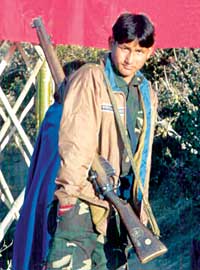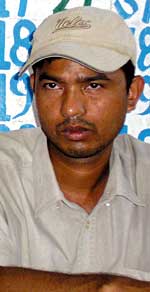 Just six km from Nepalganj in the town of Khajura, the Maoists held a three-hour mass meeting on the evening of 18 June. About 300 armed rebels dressed in combat fatigues marched openly down the streets of the town, barely a few minutes drive from the regional army headquarters.
Just six km from Nepalganj in the town of Khajura, the Maoists held a three-hour mass meeting on the evening of 18 June. About 300 armed rebels dressed in combat fatigues marched openly down the streets of the town, barely a few minutes drive from the regional army headquarters.
Even if it knew about the show of force, the army with all its sophisticated weapons and helicopters did not attack them. The rebels then got into their buses and jeeps and casually drove off along the highway to their bases in Bardia.
The Maoists were trying to thumb their noses at the military, which had just conducted an operation into their heartland in Rukum (see 'Rukum after the sweep', #205). The army said that since their soldiers did not encounter any Maoists, the rebels did not actually have control of the hills. But by parading right under the noses of the army in Nepalganj, the Maoists were trying to prove that they are still very much around.
"Our people's army is now capable of defeating the royal army," boasted Anaul, the head of the Maoists' Banke-Bardia command, while addressing the crowd in Khajura. There seems to be no shortage of bravado on both sides.
From what could be seen in Khajura, Maoist morale is high and there is considerable support for charismatic commanders like Nanda Kishore Pun (Pasang) who led the Maoist raid on army bases in Beni in February and on Achham two years ago. There have been some rebels who have opted out and surrendered to the army, but these numbers do not seem to be as high as the army makes out.  Maoists sources say several battalions in western Nepal have been upgraded to brigades and the best militants are trained and promoted to being 'urban guerrillas', equipped with captured automatic weapons and inducted into a commando task force to launch attacks in the towns and cities.
Maoists sources say several battalions in western Nepal have been upgraded to brigades and the best militants are trained and promoted to being 'urban guerrillas', equipped with captured automatic weapons and inducted into a commando task force to launch attacks in the towns and cities.
"The old regime is already nervous because they have seen what we can do, and even the royal army fears us now," says Athak, a central committee member of the western tarai rebel command.
The Maoists have said in numerous statements that their revolution has now entered a 'strategic offensive' stage and that they will now infiltrate the cities and carry out urban guerrilla attacks. This seems to have started, although in a small scale with daily news of bombings, targeted assassinations and abductions of school children and teachers in tarai towns and even Kathmandu Valley.
The movement of security forces has been restricted by devastating landmine attacks along the main highways. Security sources say they have defused numerous landmines laid along the Mahendra highway, and admit there may be more already placed under the road to be detonated when an army convoy passes through. The security forces' response to this has been to scale up fortification of their bases and increase personnel guarding government structures. Even the traffic police post in central Nepalganj now looks like a pillbox.  The Maoist-affiliated 'Tharuwan Autonomous Region' in western Nepal now holds sway over much of Banke, Bardia, Kailali and Kanchanpur. Ramchandran Chaudhary is the chief of the 'Tharuwan People's Government' and says confidently: "The old regime has been dismantled and everything is run by our government."
The Maoist-affiliated 'Tharuwan Autonomous Region' in western Nepal now holds sway over much of Banke, Bardia, Kailali and Kanchanpur. Ramchandran Chaudhary is the chief of the 'Tharuwan People's Government' and says confidently: "The old regime has been dismantled and everything is run by our government."
The indigenous Tharus of Banke have a history of rebellion. Five years ago, a group of young Tharus took up arms against exploitation by jamindars, killing some of them and chasing the others away. They later made common cause with the Maoists and their reach expanded quickly in the fertile plains of the Karnali and Rapti rivers. Already battle-hardened, they took part in an attack on a police base in Lalbojhi near the Nepal-India border, killing 12 policemen and looting rifles. They also participated in the November 2001 attack on the army base in Ghorahi.
The Maoist force is now taking the war to the east-west highway to attack security convoys. Last month the Maoists killed more than 22 armed police east of Nepalganj in a huge landmine explosion. The crater on the highway is three metres across. Five days later, 14 police personnel were killed during an attack on Chisapani led by Prabat, commander of Mangelsen 1st Battalion A Company.
Since then, Maoist hitmen have entered the town in broad daylight to kill policemen manning checkpoints in Nepalganj's crossroads. In April, the rebels drove into the centre of Nepalganj and killed eight policemen. In May, three Maoists came on bicycles to the district headquarters of Bardia in Gulariya and killed five policemen.
 The Maoists have been traveling casually across the Nepal-India border in far west Nepal. Interestingly, they are arrested neither by the Nepali police nor India's much-vaunted Special Service Bureau (SSB), which is deployed at seven entry points in Bardia alone. They are also on guard in more than 12 border areas in Dang, Kailali and Kanchanpur. In June, the rebels smuggled large numbers of camouflage uniforms through Taratal and Kotiaghat of Bardia.
The Maoists have been traveling casually across the Nepal-India border in far west Nepal. Interestingly, they are arrested neither by the Nepali police nor India's much-vaunted Special Service Bureau (SSB), which is deployed at seven entry points in Bardia alone. They are also on guard in more than 12 border areas in Dang, Kailali and Kanchanpur. In June, the rebels smuggled large numbers of camouflage uniforms through Taratal and Kotiaghat of Bardia.
The Maoists openly boast that they use the same route to regularly bring in weapons and explosives and transport them through the tarai jungles into the hills. Some militants get militia training in secret bases in India and others use the same route to take out wounded cadre to India.
In six short years, the western tarai is now a Maoist stronghold.
One reason this has worked so well is the Maoist's community-centred strategy to recruit willing young militants. The tie-up with the Tharuwan Liberation Front, the Madhesi National Liberation Front, Dalit Liberation Front and the All-Nepal Trade Union Federation have also helped in boosting recruitment.


